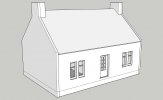Detailing of the signal box continues, but I've yet to permanently attach the stairs. A photo will follow when I do that.
In the meantime, I've drawn up the first of the Scotstown cottages based on a photo, and started cutting out the windows.

These are a row of but and ben cottages just west of Banff that face onto the North Sea, with the railway embankment behind. This one appears to have been renovated, as it has twin windows in the front, and a pretty fancy front door. I'm not convinced that this is entirely correct for my period, but it will bring some variation to the row of cottages. In reality there were 15-20 cottages, but I'll model just 4, building them individually.
Another thing that the layout really needs is more rolling stock: currently, I only have one RTR loco and 2 RTR carriages, which kind of limits operations, as well as interest. I also have two assembled Parkside wagons, and a small stash of kits, but I don't count these as none have couplings, which is where the problem is.
I know about Andrew Jackson, DG, Dingham, Flippem, Kadee, Sprat & Winkle, screw-link, three-link, and Bachmann and Hornby tension locks, but have to choose one. Many residents of this parish will have settled on one of these years ago, and can undoubted tell me about the advantages of their particular choice for their particular layout, and the disadvantages of the others.
I'll have a go at S&W couplings, as I already have a trail pack of 4mm finescale autocouplers (T/AC3/3) which were recommend by my mentor @Ben Alder and over which I have been procrastinating for more than 8 years. I'll try single-ended couplings - a bar at one end of a wagon/carriage/loco, and a hook at the other - and chemically blackening the brass to hopefully make them less obtrusive. Since prototype operations require up trains into Banff to run tender first, loco fronts will have the bar, thereby setting the tone for the rest of the rolling stock.
The trial pack comes with mounting plates and instructions, so it should be easy, right? What could go wrong?
8/8/24: added Flippem
In the meantime, I've drawn up the first of the Scotstown cottages based on a photo, and started cutting out the windows.

These are a row of but and ben cottages just west of Banff that face onto the North Sea, with the railway embankment behind. This one appears to have been renovated, as it has twin windows in the front, and a pretty fancy front door. I'm not convinced that this is entirely correct for my period, but it will bring some variation to the row of cottages. In reality there were 15-20 cottages, but I'll model just 4, building them individually.
Another thing that the layout really needs is more rolling stock: currently, I only have one RTR loco and 2 RTR carriages, which kind of limits operations, as well as interest. I also have two assembled Parkside wagons, and a small stash of kits, but I don't count these as none have couplings, which is where the problem is.
I know about Andrew Jackson, DG, Dingham, Flippem, Kadee, Sprat & Winkle, screw-link, three-link, and Bachmann and Hornby tension locks, but have to choose one. Many residents of this parish will have settled on one of these years ago, and can undoubted tell me about the advantages of their particular choice for their particular layout, and the disadvantages of the others.
I'll have a go at S&W couplings, as I already have a trail pack of 4mm finescale autocouplers (T/AC3/3) which were recommend by my mentor @Ben Alder and over which I have been procrastinating for more than 8 years. I'll try single-ended couplings - a bar at one end of a wagon/carriage/loco, and a hook at the other - and chemically blackening the brass to hopefully make them less obtrusive. Since prototype operations require up trains into Banff to run tender first, loco fronts will have the bar, thereby setting the tone for the rest of the rolling stock.
The trial pack comes with mounting plates and instructions, so it should be easy, right? What could go wrong?
8/8/24: added Flippem
Last edited:












